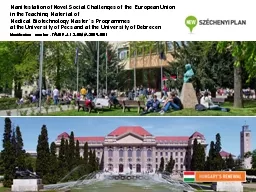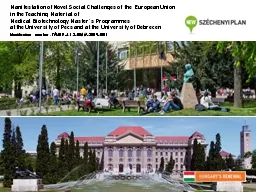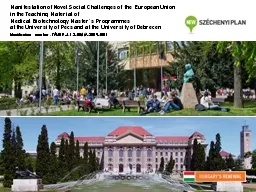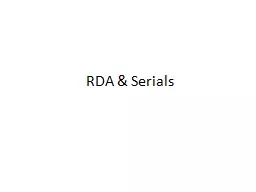PPT-Manifestation of Novel Social Challenges of the European Un
Author : test | Published Date : 2016-07-10
in the Teaching Material of Medical Biotechnology Masters Programmes at the University of Pécs and at the University of Debrecen Identification number TÁMOP412081A20090011
Presentation Embed Code
Download Presentation
Download Presentation The PPT/PDF document "Manifestation of Novel Social Challenges..." is the property of its rightful owner. Permission is granted to download and print the materials on this website for personal, non-commercial use only, and to display it on your personal computer provided you do not modify the materials and that you retain all copyright notices contained in the materials. By downloading content from our website, you accept the terms of this agreement.
Manifestation of Novel Social Challenges of the European Un: Transcript
in the Teaching Material of Medical Biotechnology Masters Programmes at the University of Pécs and at the University of Debrecen Identification number TÁMOP412081A20090011 Cognitive. in the Teaching Material of. Medical Biotechnology Master’s . Programmes. at the University of . Pécs. and at the University of Debrecen. Identification number: TÁMOP-4.1.2-08/1/A-2009-0011. Genetic. in the Teaching Material of. Medical Biotechnology Master’s . Programmes. at the University of . Pécs. and at the University of Debrecen. Identification number: TÁMOP-4.1.2-08/1/A-2009-0011. Neurological. in the Teaching Material of. Medical Biotechnology Master’s . Programmes. at the University of . Pécs. and at the University of Debrecen. Identification number: TÁMOP-4.1.2-08/1/A-2009-0011. Nutrition,. in the Teaching Material of. Medical Biotechnology Master’s . P. rogrammes. at the. . University of . Pécs. and at the University of Debrecen. Identification. . number. : TÁMOP-4.1.2-08/1/A-2009-0011. in the Teaching Material of. Medical Biotechnology Master’s . P. rogrammes. at the. . University of . Pécs. and at the University of Debrecen. Identification. . number. : TÁMOP-4.1.2-08/1/A-2009-0011. in the Teaching Material of. Medical Biotechnology Master’s . Programmes. at the University of . Pécs. and at the University of Debrecen. Identification number: TÁMOP-4.1.2-08/1/A-2009-0011. Mitochondrial. in the Teaching Material of. Medical Biotechnology Master’s . P. rogrammes. at the. . University of . Pécs. and at the University of Debrecen. Identification. . number. : TÁMOP-4.1.2-08/1/A-2009-0011. RDA Toolkit. CONSER RDA Cataloging Checklist for Textual Serials (DRAFT). CONSER RDA Core Elements. Where’s that Tool? CONSER RDA Cataloging – Interim Period. “Bridge” training (Available fall 2012) . in the Teaching Material of. Medical Biotechnology Master’s . P. rogrammes. at the. . University of . Pécs. and at the University of Debrecen. Identification. . number. : TÁMOP-4.1.2-08/1/A-2009-0011. V/FRBR-CT | Design Sketches : #15-1. Adding & editing work structure. Case: Barber’s String quartet, Op. 11. These slides illustrate the following design ideas : . The basics of adding work structure. A Tour of . RDA and the (. BSR) for Textual Monographs in MARC tag . order. Acronyms (We all should know). BSR=. LC/PCC PS=. WEMI=. PFC=. AAP=. UCB PS=. BIBCO Standard Record. Library of Congress/Program for Coop Cat. Policy Statements (RDA equiv. of LCRI). in the Teaching Material of. Medical Biotechnology Master’s . P. rogrammes. at the. . University of . Pécs. and at the University of Debrecen. Identification. . number. : TÁMOP-4.1.2-08/1/A-2009-0011. Discover the truth and the facts about 15 Minute Manifestation™ PDF, eBook by Eddie Sergey. Click \"SHARE\" and \"DOWNLOAD\" to read the document offline. I3U Project Meeting & Technical Workshop. September 14-15. . . 2015, Vienna. Berenike Ecker. Commitment 26. Launch a Social Innovation pilot; promote social innovation in European Social Fund. ".
Download Document
Here is the link to download the presentation.
"Manifestation of Novel Social Challenges of the European Un"The content belongs to its owner. You may download and print it for personal use, without modification, and keep all copyright notices. By downloading, you agree to these terms.
Related Documents














